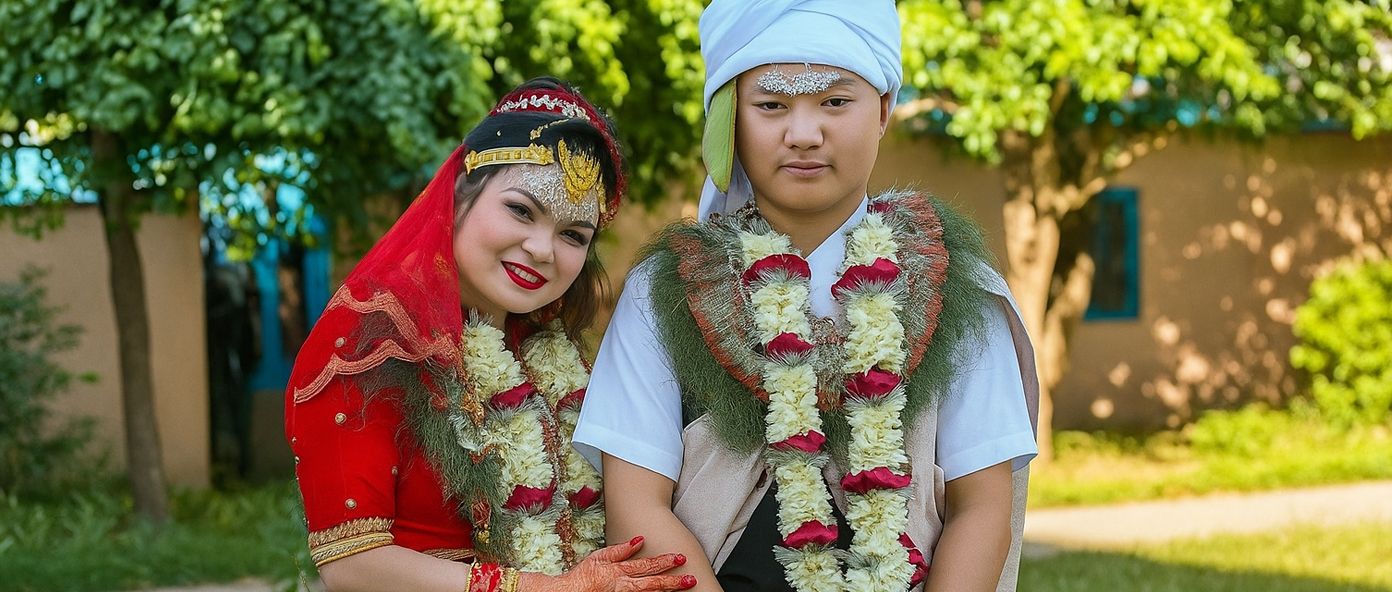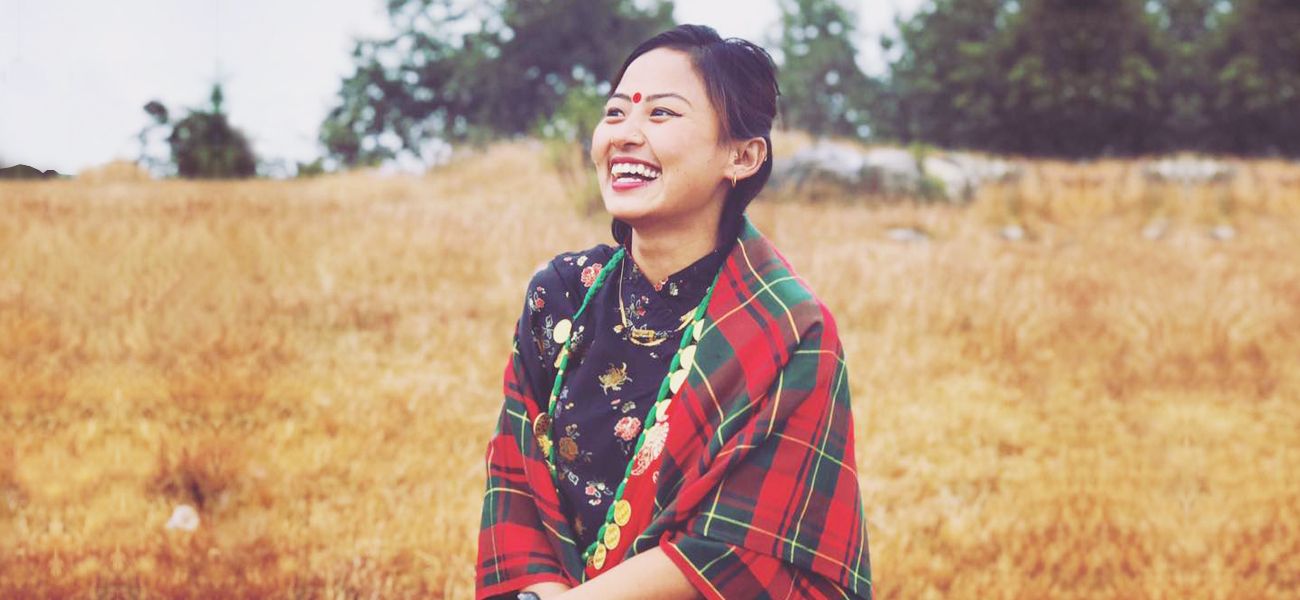Magar Weddings: Rituals of Kinship and Social Balance
The Magar marriage system serves as a central institution within Magar society, reflecting both enduring rituals and diachronic transformations shaped by shifting social and cultural contexts. Marital practices such as cross-cousin marriage and clan-based exogamic taboos articulate cultural norms that shape kinship ties and uphold the social boundaries of the Magar community. In traditional Magar culture, marriage is a public, ancestral, and communal institution instead of a mere dyadic romantic union. These practices underscore the collective nature of marriage, positioning it as a mechanism for social reproduction and cultural continuity across generations. In this way, marriage among the Magars operates as both a form of negotiation and reinforcement of identity, integrating individual choice within broader communal imperatives.
Historically, cross-cousin marriage lay at the heart of Magar matrimonial alliances. A preferred pattern involved a man marrying his mamacheli, the daughter of his maternal uncle. This union was a practical arrangement and a culturally sanctioned ideal that reaffirmed long-standing ties between wife-giving (Maiti) and wife-receiving (Kutumba) lineages. If the preferred mamacheli was unavailable, a younger girl from the same maternal line could still be considered. Such relationships were encouraged from a young age, often expressed through playful teasing and familiarity, which functioned as a culturally recognized courtship dynamic. In sharp contrast, marriage with a phupucheli, the daughter of one’s paternal aunt, was strictly prohibited. This distinction underscores a deep moral architecture within Magar kinship, where certain forms of closeness are celebrated and others considered transgressive. Moreover, reciprocal marriage between the same two lineages across generations, where a wife-giving clan becomes a wife-receiving one, is regarded as a violation of social balance, tantamount to incest within Magar ethical reasoning.

As society changed, so too did the forms of marriage. New ideas brought through education, migration, and state influence softened older certainties. Yet even with evolving practices, the underlying principles of lineage continuity and clan exogamy remain central. A marriage in Magar culture and tradition is as much a ritual transaction between families as it is a personal choice. It links households, affirms social responsibilities, and reestablishes relationships between clans. Ritual acts such as offerings, blessings, and assigned roles during ceremonies reflect a worldview in which personal unions are deeply embedded in collective identity.
Traditionally animist and later shaped by Hindu and Buddhist syncretism, Magar society maintains strict rules of clan exogamy. Marriages are prohibited within the same thar (clan), a rule intended to ensure genetic diversity and uphold ancestral boundaries. Kinship is both genealogical and spiritual realities. In the Kham Magar regions of the Atharah Magarat, shamans known as Ramma are regularly consulted before a marriage takes place. Their role is to sense spiritual disturbances, interpret ancestral signs, and ensure that the union aligns with unseen forces. Within this worldview, marriage carries meaning that extends beyond the material or personal. It forms a bridge between generations, links the household to the realm of spirits, and affirms the individual’s place within the larger social and cosmological order.

Among the Magars, marriage functions as more than a personal union between two people; it acts as a reaffirmation of social order, lineage continuity, and ancestral connections. Arranged marriage, known as Lagañya, stands as the most widely accepted and ritually endorsed form. Elders take the lead in these unions, relying on memory, clan ties, and perceived compatibility to negotiate the match. Engagements include exchanging symbolic offerings such as locally brewed alcohol, betel nut, and livestock, followed by rituals that unite two individuals as well as their kin groups. These alliances are carefully crafted, respecting rules of clan exogamy and reinforcing established social boundaries.
Elopement or love marriage (Odañya), represents a shift in generational attitudes. Couples who elope without prior approval often return later to seek ritual recognition and family reconciliation. Although once viewed as transgressive, these unions have gained increasing acceptance, especially in areas influenced by education and urban lifestyles that emphasize autonomy and love. Still, the reconciliation process remains vital. It involves offerings, dialogue, and the construction of a new consensus founded on retrospective acknowledgment of the couple’s decision rather than prearranged negotiations.
Additional forms of union add complexity to the marriage system. Capture marriage, referred to as Jari Biha in Nepali, and levirate marriage, Bhauju Biha, were once part of the social fabric but now mostly survive as remnants of earlier times. Jari involved taking a woman, sometimes with consent, sometimes without, accompanied by ritual compensation to her natal family. Levirate marriage involved a younger brother marrying the widow of his elder sibling, ensuring economic continuity and preserving kinship roles. These practices, though still present in some isolated areas, now occupy marginal positions in Magar ritual life and lack the formal recognition accorded to Lagañya or Odañya.
While native terms exist for arranged and elopement marriages, others often lack indigenous labels. This absence has led some to question whether practices like jari, levirate, or symbolic cohabitation are originally Magar or borrowed from dominant cultures over time. However, such views risk ignoring the realities of cultural change. In oral societies, language loss and assimilation are common, and the absence of specific terms does not mean practices have vanished. Instead, customs are lived through daily habits rather than always being explicitly named.
In areas such as the Barah Magarat, where Nepali has replaced Dhut in everyday speech, many native expressions have faded even as the social structures they described endure. Although Jari Biha is a Nepali term, the practice of restitution in disrupted marriages reflects Magar values of balance, reciprocity, and social healing. Authenticity here depends less on linguistic purity and more on whether the underlying values and relational principles continue to embody a distinctly Magar worldview.
In Magar marriage rituals, symbolic actions and material offerings are central to affirming social relationships, ancestral blessings, and communal legitimacy. Alcohol, particularly Lee (Jaad or Rice Beer) and Mudd (Raksi or Traditional distilled spirit), serves a dual role as both a celebratory drink and a ritual object imbued with cultural significance. During matrimonial negotiations, the exchange and consumption of alcohol carry layered meanings. For example, when a marriage proposal is presented, the groom’s family offers alcohol in a wooden container called Koriya to the bride’s family. The acceptance of this offering signals agreement to the union, while refusal requires the return of any initial gifts (often doubled) in a practice known as Sahi. Certain types of alcohol hold specific ceremonial importance; a three-day fermented rice beer, Jahman, is traditionally given to wedding guests and the groom’s party as a symbolic blessing before their departure. Across many regions, especially in western Nepal, alcohol is the preferred medium for hospitality and ritual purity, at times taking precedence over other customary offerings such as yogurt or curd.
Symbolism in Magar marriage extends beyond material offerings to include spatial arrangements and ritual performances. In the bride’s natal home, she is accorded a position of honor, seated to the right and receiving the Tika, a ritual blessing made with rice grains applied to the forehead, before the groom. This order is deliberately reversed after marriage, signifying her incorporation into her husband’s lineage and the resulting shift in kinship hierarchy. In cases of elopement, reconciliation rituals known as Sodhni require both bride and groom to present jars of alcohol to the bride’s family, affirming mutual consent and restoring family relationships. Collectively, these ritual elements sustain the Magar marriage system’s connection to ancestral cosmology, weaving together domestic life, community values, and spiritual order.

Marriage rituals are elaborate affairs among the Magars, functioning as structured processes of kinship affirmation and social legitimacy. From the outset, the role of the Lami (marriage intermediary) is vital. The Lami, often a maternal uncle (Mama) or a sister’s husband (Jwaaichela), delivers the marriage proposal along with Sagun, a symbolic offering comprising items like Raksi (distilled alcohol), Tarul (yam), honey, and money. Acceptance of the Sagun signifies consent to the union, while refusal halts proceedings. In many regions of Central-West Nepal, only an odd-numbered group of male relatives accompanies the proposal, and the offering is reciprocated by the bride’s family through a second set of Sagun, thus formalizing the engagement in a reciprocal framework.
The ritual of bringing the bride to the groom’s home (behuli bhitraune) is central to the marriage process and is marked by spatial and symbolic rites. Before entering the house, the bride sets down a water-filled Amkhora (brass jug) at the threshold, symbolizing purification and auspicious entry. A rooster is sacrificed near the doorway as an offering to ancestral spirits and for spiritual safeguarding. The bride carries the jug inside and pours a few drops onto her mouth, marking her acceptance into the new household. In some areas, Chamal Tika, made of Dahi (curd) and Chamal (rice grains) is applied to the foreheads of both bride and groom by elder kin, beginning with the bride. This reversal of ritual order before and after marriage signifies the transition from natal to affinal kinship, and the shifting roles and status the bride undergoes. The application of tika, tying of Dubo-Paati (sacred wheatgrass and leaves), and collective feasting all contribute to affirming the union within the wider social and spiritual order.

In cases of elopement (Odañya), reconciliation rituals such as Sodhni serve to reintegrate the couple into normative kinship structures. Within three days of elopement, the groom’s party is expected to bring Raksi (distilled alcohol), Roti (traditional bread), and Jaaḍ (rice beer) to the bride’s family to seek retroactive approval. Failure to do so invites social sanction. The ritual offering signals accountability, respect for lineage, and the mending of relational ruptures. A further ritual, Chorkorya, involves delivering the right foreleg of a previously sacrificed goat or buffalo, kept aside during the behuli bhitraune, as a token of symbolic completion of the marriage process. This act serves as a restitution and also as an embodied communication of ritual closure and reparation.
The final phase, Janti jaane (bridal procession), represents the public legitimization of the marriage and involves exchange, gifting, and symbolic hospitality. On the day appointed by the bride’s family, the groom’s party arrives with ceremonial gifts, called Danda or compensation: a minimum of five containers of raksi, hundreds of Roti, live animals, and women’s traditional garments. These offerings are meant to reduce the economic burden of the bride’s family and to honor reciprocal ties. During this event, relatives perform reciprocal Dhogbheṭ (gestural greetings), and elders introduce the bridegroom to the extended kin. The wedding concludes with a communal feast and singing, often lasting up to three days.

Magar culture considers marriage functions a calibrated system of ritual acts to shape and stabilize shifting kinship ties. These rituals, while diverse across regions and responsive to social change, continue to serve as vital expressions of communal identity, ancestral reverence, and relational ethics. Each gesture carries a symbolic weight that extends far beyond its surface form. These acts do not operate in isolation but are woven into a broader ritual grammar through which households, lineages, and ancestral obligations are continuously aligned.
Even as external influences reshape certain customs, the underlying principles of reciprocity, clan respect, and ritual coherence persist, anchoring marriage as both a cultural continuity and a living tradition. Through this process, the institution of marriage emerges as a dynamic field where memory, belonging, and cosmology are enacted and renewed.












